Pregame, Day One, Day Two!
In which I talk about background, travel details, my experiences & expectations.
Orquevaux residencies seem to come in three durations, depending on the year’s schedule: two weeks, three weeks, or one month.
Each curated group is called a cohort. I’ve estimated Orquevaux hosts at least 240 artists per year, with future plans to host more.
I have the greatest esteem for folks who hit the ground running for a two-week residency in Orquevaux. Consider a day to set up and take down studios, get through the open studio, and Shipping Day…that cuts a fourteen-day stint down to nine or ten.
The Chateau has several Instagram feeds that are worth following (however much I loathe Meta & what it did to Insta). You get glimpses of what each residency cohort achieves, their discoveries and joys.
Just search for Chateau d’Orquevaux on Instagram.
The history of Orquevaux is rich, especially if you delve deep with a little translation help. Here is a start: https://www.chateauorquevaux.com/history
I chose a three-week residency because it was the longest offered when I got accepted in March 2024, and I could just barely afford it on some previous art commissions and a bequest from my late father. Thank you, clients! Thank you, Dad!
I had almost a year to plan what to take and what to make. I dropped my previous wild big ideas that would be suitable for local AZ venues (320 pounds of large glass beads and beaded ropes, in three installations like this), but *not* hauling 6000 miles away to France.
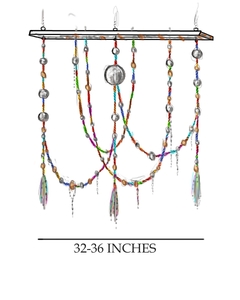
Gradually, I settled on several easily packed fiber art pieces, much lighter weight, and open-ended so I wouldn’t feel guilty if I didn’t finish them at Orquevaux.
I still ended up taking way too much.
Remember my warning about luggage? I took two large roller cases, one carry-on duffle bag, and a large Travelon crossbody handbag that was *still* not big enough. I had to leave my laptop behind.
I shipped 3 supply boxes to Orquevaux beforehand ($750USD via FedEx, pre-tariff): small glass beads, craft lamps, pallette paper block, magnifier headset, embroidery and sewing machine needles, sewing thread on cones, polyester cord, fabric, and a wire and crystal lantern with a rainbow LED candle.

This lantern was out & lit whenever I was in studio, to let people know it was fine to come in & visit.
Shipping my sewing machine would be too much there and back with insurance, so from Amazon France* I bought a student-grade Brother mechanical machine that would be good enough for basic piecing & finishing. I planned to leave it there with accessories as a free Art Cave gift for later cohorts.
*I did not use Amazon France because I wanted to, but because it proved almost impossible to buy a sewing machine in time from a shop in Paris or Chaumont (the nearest city to Orquevaux). I gave up at T-minus 3 weeks and ordered from Amazon.
After packing, repacking, and nearly losing my mind, I added a sketchbook, pens, acrylic ink, two book arts projects, a 1995 Travelers’ Tales France essay book (Goodwill, more on this later), and two larger tapestry pieces.
I still overpacked, heeding the warnings that Orquevaux is basically in the middle of nowhere. Chaumont is 45 minutes away by car. Amazon runs out there, but it is pricey!
On March 11, 2025, at 12:15pm, I hit Phoenix Sky Harbor Airport with my two Lark roller suitcases filled with bags of embroidery floss, sewing thread, my project kit bags, four changes of everyday clothes, one dressy overvest, beaded art sandals, a finished fiber art book, one big black wool coat, one secondhand raincoat, a couple of hats, my hiking cane, and my hiking boots.
Even after checking my bags with Delta Airlines (my commuter flight to LAX), I had my crossbody and duffle bag to wrangle across Sky Harbor (2000ft), and the vast LAX concourses (3 miles). I’d already been up for 36 hours (including hiring a tow truck at 3am that morning to donate a non-running vehicle to Habitat For Humanity, so I could clear a residential garage. )
So I wasn’t thinking lucidly, or I would have asked for a ride or one of the luggage roller carts. Use these, they’re wonderful!
I walked 5.27 miles that day. Oof.
Raining at Phoenix, raining at LAX. I did get to see hints of the dramatic LA lightscape through gaps in the clouds when we took off.
A while back, I based the fiber book ‘Night Flight’ off nighttime Phoenix and LAX aerial photos.
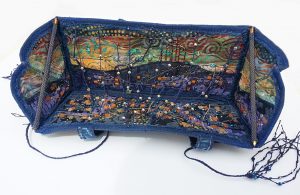
The trip east was at mostly at night. Black night, a few stars, the moon on an Air Canada wing. 10 hours in the air. Nothing to see. Cloud cover hid the cities and towns below.
I didn’t sleep. I read from the Travelers’ Tales book, an interesting 30-year-old slice of the French travel experience. I tried not to build any expectations of my own trip (impossible, but worth the effort to temper preconceived ideas!)
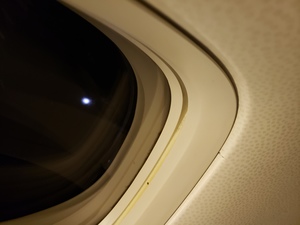
Air Canada planes have seatback HUDs that can show movies, videos, and flight details including cameras looking down over the flight path.
Even after dawn over the North Atlantic, all I really saw were clouds scrolling down the screen, with glimpses of dark ocean pleated like silk by vast long waves.
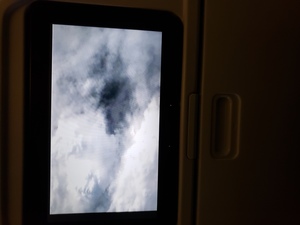
Hypnotic.
We landed in clouds and drizzle.
I’d been smart enough to pay Air France for concierge service upon arrival in France. Worth the money. My assistant helped me get through the equally vast Charles de Gaulle Airport to a taxi, which took me down to my hotel down in Le Marais.
Yeah, I could have found a budget hotel near the train station I’d need the next day. But another artist I knew had recommended the historic, quirky Hotel de Roubaix on Rue Greneta.
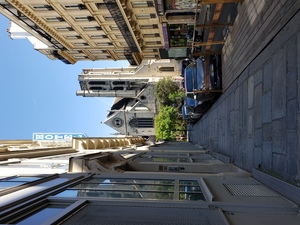
This place is tucked away from several major streets, near a Metro station, and just a mile or so north of the Seine.
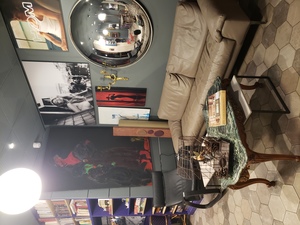
A mix of genteel marble, mirrors, warm wood, Sevres porcelain, and edgy modern pop art, Hotel de Roubaix is cozy and dog friendly, with a great breakfast buffet and comfortable beds. Bathrooms are excellent.
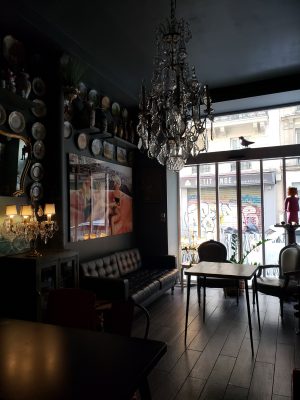
The salon is amazing, offering extraordinary glimpses of people-watching along Rue Greneta.
I found a small grocery store in walkable distance and grabbed cold cut chicken, fresh apricots, and some decent cheese for dinner, because I was too tired to go to a real restaurant. Hotel de Roubaix offers a fridge, microwave, and eating spots for guests to grab leftovers or snacks, since eating in-room is discouraged. (I did obey that rule. Mostly.)
*Then* I slept.
I split my time there, staying one night in the middle of March, with three more nights the first week of April. In Q1 2025, Air France only ran three flights a week to Phoenix AZ: Monday, Thursday, and Saturday. Since the residency ended on a Tuesday, I’d decided to stay in Paris during that ending week and take the Saturday flight home. It would become a necessary decompression.
On to Orquevaux!
Early on March 13, a taxi took me up to Gare de l’Est, the big train station that is the western terminus of the Paris-Strasbourg railway serving eastern France and Germany.
Up to this moment I’d been a solo traveler. Thanks to a private Instagram group, I was in contact with more members of my cohort. Soon, we had a luggage fort (safety in numbers!) as we waited for our train to Chaumont.
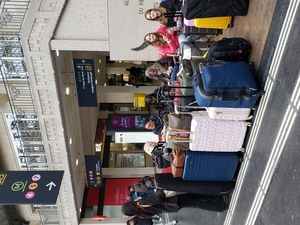
Here, dear readers, is why only a madperson takes two large suitcases and a big duffle bag on a *commuter train in another country*.
My fellow residency folks carried varying amounts of gear, but I probably had two of the largest suitcases. Thanks to selfless cohort members, I stowed my ridiculous luggage.
French commuter trains have limited amounts of storage for luggage, and often have less than five minutes at stops. By the time we neared Chaumont, I’d dragged my suitcases to an exit near my seat.
French commuters have to deal with travelers like me. It’s a wonder the locals tolerate us as well as they do!
It was raining, again, so I didn’t photograph much of that trip.
Chaumont is a mix of medieval and modern city built atop a hill with steep cliffs. Upon arriving (still in a rainstorm), we were scooped up by Chateau staff and two vans.
The drive from Chaumont to Orquevaux is…interesting. A tall, famous aqueduct. Narrow winding roads, wide open farmland, huge wind turbines looming over small villages, patches of forest.
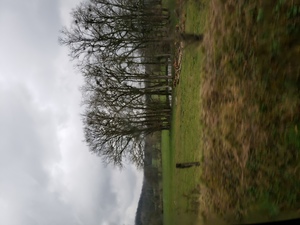
For the last few kilometers we paced a slender glimmering river…La Manoise.
Then a turn through the village of Humberville, a few more fields and groves, then we had a glimpse of a long lake, misty forest, and the dollhouse pink and white rectangle high on a western hill…the Chateau d’Orquevaux.
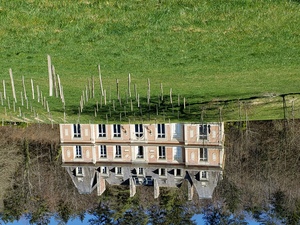
That first evening, we had champagne and cheese, a welcome speech, our first dinner from Chef Marie (the food here is so good!), and assignment to our rooms.
As I’ve mentioned before, I stayed in the village at Maison LaVigne, with my incredible housemate Fiona.
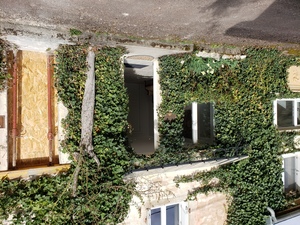
The next morning we scrambled to organize our studios, and a small group of us went off in a van for our Chaumont shopping trip.
(Fiona stayed behind because Exhaustion and studio setup. Follow her on YouTube here!)
I had a shopping list consisting of gluten free pastries, glass beads, good chocolate, silk flax flowers on long stems, and a hanging fabric organizer.
I had reasons for all of it.
Once back in Orquevaux, I spent the time until dinner organizing my extremely spacious studio (easily 35 x 15 feet).
I’d originally been assigned the end studio with plenty of natural light, but I need controllable *bright* halogen or LED for my work. Fiona needed natural light, so I did my happy Grandma Bulldozer routine & talked the Director into switching us. Perfect outcomes for both of us.
Look at this place!
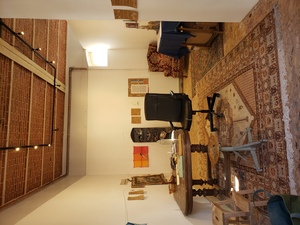
I’d been sketching various projects, so I had solid plans for the following days:
Sew on the Arbor Borealis tapestry that I hadn’t worked on for a decade.
Do some needlepoint additions to a commercial tapestry I’d found at Goodwill last year.
Work on several small book arts pieces.
Finish and donate Wellspring, my wood deer sculpture piece.
I did all of that, to varying degrees.
Beyond simply hanging out with other creatives on their own journeys in stunning locations, my biggest takeaway from this trip is an honest reassessment of my studio needs at home, and the spaces I can actually work within.
I have some valuable insight from the residency founders, and new online sales platforms to try.
Will this residency change my art strategies? Not right away. I live in an art-heavy state but due to many reasons I do not currently show art in my home state (why, is a different blog post!)
But Orquevaux shook me out of my habits and showed me what is possible with relatively inexpensive technology.
Did I need to fly 12,000 miles to recalibrate my artist brain, at a steep financial & emotional cost (and possibly risk the health of someone I love?)
Yes, I did.
I’ll turn 60 this year. Opportunities like this are only becoming less feasible for most of us, for financial, environmental, and political reasons. I could have postponed to next year, but I reasoned next year might become ‘too late’.
Next post: the gritty details of my art in Orquevaux, and some adventures!
I’m enjoying the detail of your accounts. The challenges of transporting manageable stocks of materials are REAL. How to decide? How to cull? How to pack? How to manage the large cases that are necessary? My hat is off to you for your sewing machine solution.
I ended up packing waaay too much!